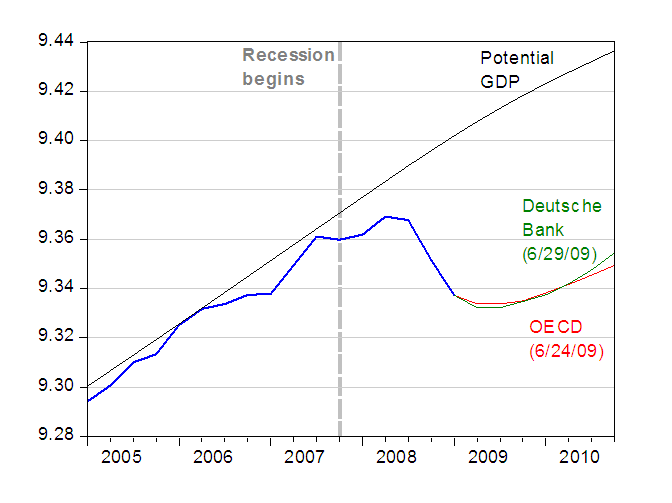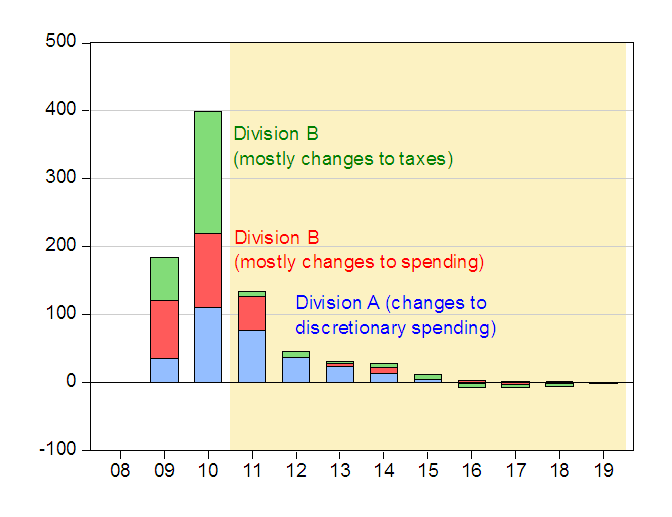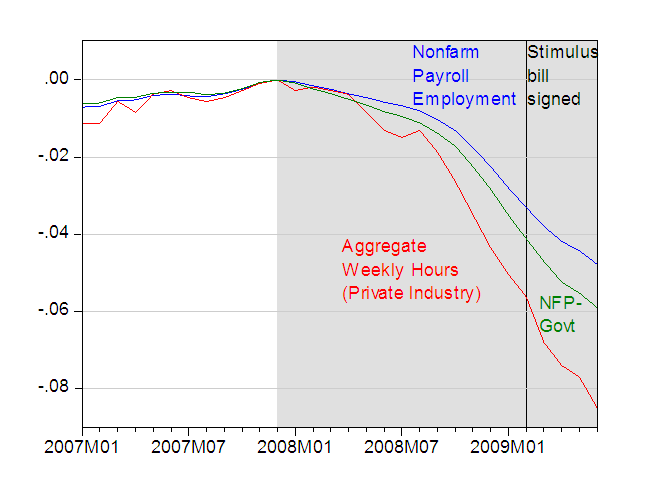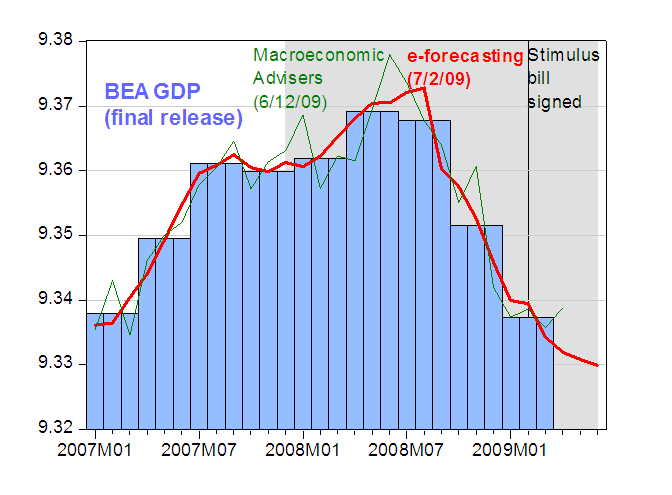A “W” Recession?
Martin Feldstein has recently raised the possibility that we might experience a relapse into recession (a beautiful symmetrical W), with the next dip in 2010. In my view, this means (1) we should have opted for a bigger and better composed stimulus package, and (2) the timing of expenditures in the stimulus package might not be as problematic as many commentators have indicated. From Bloomberg:
“I think we”re going to see a temporary substantial improvement,” Feldstein, the former head of the National Bureau of Economic Research and a Reagan administration adviser, said today in an interview on Bloomberg Radio. “I emphasize the words temporary and substantial.”
Feldstein — a member of the private panel that dates the start of recessions and recoveries — suggested the economy will contract into next year, and that the pattern of economic turnaround will be more of a seesaw than what he called “a beautiful symmetrical W.”
Interestingly, neither the OECD nor Deutsche Bank project such a “W” shaped trajectory. Nor do any of the forecasters in the May WSJ survey.

Figure 1: Log real GDP (blue), OECD forecast of 24 June (red), Deutsche Bank forecast of 29 June (green), and CBO estimate of potential GDP of January 2009 (black). NBER defined recession dates shaded gray. Source: BEA, 2009Q1 final release, OECD, Economic Outlook No. 85, Deutsche Bank, “World Outlook: Recovery Ahead,” Global Markets Research (June 29, 2009).
That doesn’t rule out the possibility of this occurring. I can think of several reasons for thinking a W shaped recession would be plausible. The most plausible in my mind would be if the world economy failed to rebound sufficiently to provide enough externally generated aggregate demand via exports. The other possibility is that monetary policy tightens too soon, as inflation hawks press their case (see FRBSF President Janet Yellen‘s assessment, as well as this post).
The Timing of Stimulus Spending, Again
At this juncture, it’s useful to recall that the peak in spending would be in FY2010. As shown in this figure from this post, roughly half of the stimulus occurs in from October 2009 to September 2010.

Figure 2: Estimated spending and tax revenue reductions, per fiscal year, embodied in HR 1 final version. Shaded areas pertain to spending occurring outside of the 19.5 month time frame. Source: CBO, H.R. 1, American Recovery and Reinvestment Act of 2009 (February 13, 2009).
I know that there’s going to be a big group of commentators who will argue the multiplier is 0, but I’ll go with the CBO and assert there will be some impact of indeterminate amount. In addition, if the critics who have argued that the spending is occurring much too slowly are correct [0], then the actual spending will more likely occur in this “dip” period that Feldstein is predicting. (Previously, I argued that the recession was likely to be long, so speed would not be of the essence [1]).
Mendacity Alert
Figure 1 also demonstrates why the critics of the stimulus bill that cite today’s nonfarm payroll losses are being disingenuous. It was understood that most of the spending would not occur in FY2009, and even that which occurred within FY2009 would be toward the end of the year. (Really, did anyone expect the impact to be discernable in four months after the bill’s passage?).

Figure 3: Log nonfarm payroll employment (blue), log nonfarm payroll employment minus government workers (green), log aggregate weekly hours in private industry (red), all normalized to zero in 2007M12. NBER defined recession date shaded gray, assuming the recession end has not arrived by June 2009. Vertical black line denotes ARRA signed into law in February. Source: BLS, Employment Situation June release.
The series in Figure 3 are plotted in log terms. This means that changes in the slope indicate changes in the percentage rate of change in the indices. The fact that the slopes for the blue and green lines are flattening means the rate of deterioration in employment is declining. However, there was little evidence before that the labor market was improving even before this morning’s release [2], and that point is reiterated today by Jeff Frankel.
Interestingly, if the critics of the stimulus bill focus on changes in trends post ARRA [i] [ii] [iii], they might regret it in the future (well, assuming they’re interested in internal consistency of argument). That’s because the rate of GDP decline does look like it’s stabilizing in 2009Q2, at least based on early readings from e-forecasting and Macroeconomic Advisers. (Once again, the series are plotted in log terms, so changes in slope can be identified as changes in the percentage growth rates.)

Figure 4: Log real GDP from BEA (blue bars), and Macroeconomic Advisers 6/12 (green line), e-forecasting 7/2 (thick red line), all in Ch.2000$, SAAR. NBER defined recession date shaded gray, assuming the recession end has not arrived by June 2009. Vertical black line denotes ARRA signed into law in February. Source: BEA, GDP 2009Q1 final release; Macroeconomic Advisers [xls], e-forecasting, and NBER.
Valid, and Not so Valid, Criticisms of the Stimulus Bill
I do think the one big failings of the stimulus package that I highlighted back in March is now coming to light: the cut in the transfers to states that came about as a result of the compromise with the Senate Republican moderates [3]. As the states grapple with truly challenging budget shortfalls [4] [5] [6], they are cutting spending and raising taxes — exactly the measures that the textbooks say are not ideal from a countercyclical stabilization policy standpoint.
One digression on bureaucratic procedures. In the day before yesterday’s NYT, David Leonhardt chastises the Administration for using models that were too optimistic. I certainly agree in retrospect the Administration’s baseline forecast was too optimistic. Two observations: First, it’s important to realize that the end-February assessments were based upon early January forecasts completed by the previous (Bush) Administration, and finalized on February 3 [7]. When taken in that light, I don’t believe the forecasts were that much out of line with private sector forecasts [8]. Second, (in my limited experience) if one is to deviate from a model, it helps to have a formal alternative model to use. It’s not clear to me an alternative formal model that had widespread acceptance exists, so, it’s all fine and good to say a more pessimistic model should’ve been used, but it’s hard to make a case for that in a bureaucratic setting, especially if it deviated from the Blue Chip.
Hmmmm ….
When you are in a war, the important thing is to fight the correct enemy. Our current enemy is presented here as a business cycle recession with credit defects, causing liquidity shortages.
If you look at credit creation as a hedge against rising energy costs beginning in 2002 it is possible to cast the current situaton as an energy price problem, instead.
Added stimulus that has reached the economy so far has maintained avarage oil costs @ a level above $45 a barrel. The average cost for 2008 was $70 a barrel and the current price is very close to $70 a barrel. The assumption that this price is not sufficient to effect the economy is just that … an assumption.
The Federal Reserve considered the increases in oil price from 2002 onward to be sufficient to justify increasing Funds rate. Perhaps this was overdue, but the Fed did misunderstand both the deflationary pressure generated by increased oil cost as well as the aim of the finance industry during that period to render fungible all cost inputs to finance – including oil costs.
You can read minutes of FOMC meetings on the Federal Reserve System webpage.
When the Fed raised interest rates beginning in 2003, it shattered the ability of structured finance to maintain asset bubbles in real estate and structured securities. Cheap credit became expensive and when added to expensive oil, the total costs began to eliminate profits and generate defaults.
The Fed is in an identical dilemma now – whether to raise rates in the intermediate term or reduce the flows of liauidity or unwind its grossly unbalanced ‘balance sheet’. It clearly cannot continue to expand its holdings of bank etc. paper forever. However, to reverse the easing process would shatter the ability of the now- damaged money brokers to maintain the asset bubble in public finance!
We are going in circles!
What does this tell you? That the problem isn’t in finance per se, since neither Wall Street nor the Fed are interested in remediating credit risk. The problems are elsewhere and there is nowhere to look but at oil prices.
Oil over $45 a barrel is an economy killer. Unfortunately, the clock cannot be turned back to the time of cheaper oil. Alas, valuable real resources have been irretrievably consumed and the underpinnings of industrial ‘progress’ are currently being priced into systemic unaffordability by the industrial process itself.
This being the case, it is more likely that the recession will be more of a ‘stair step’ rather than an alphabet sort of thing. The stairs will descend and as no person in any establishment is taking the energy issue seriously except for desperate efforts to restart the bubble/hedge machine, the stairs will descend in monotony punctuated with terror until either the bottom is reached – a 14th century way of life for all Americans – or until the establishment wakes up and starts crafting an alternative strategy.
This is a war and the first step is to correctly identify the enemy. The second is to engage directly. The simplesr and most direct form of attack on this problem is to conserve oil by not using it. Simple – hard, too. But it will be done. Either by planning, discipline and good policy or by the back steps.
I agree with Feldstein. Dynamics of accumulated capital ( I am not sure if there is any, but the rise in oil prices despite recession suggests there is.)
Another possible scenario for a W shape is that cap and trade legislation is passed which increases the cost of everything, causing the economy to fall back into a steep decline.
Previously, I argued that the recession was likely to be long, so speed would not be of the essence
The logic of this statement escapes me. If you actually believe that stimulus will create a recovery how can you argue that waiting to inject the stimulus is a good thing? The argument is internally contradictory.
Lets look at the argument.
1. We are in economic decline so we need monetary stimulus to generate a recovery.
2. But stimulus will have no impact on recovery because the recession will be long even with a stimulus.
3. The recession will be long so we shouldnt inject stimulus until the economy begins to start recovery (implying that the stimulus should be injected as the recession enters recovery).
4. But if the recession begins to recover even before any stimulus is injected then why do we need stimulus?
5. Internal contradiction – stimulus generates recovery, but recovery must begin before we stimulate.
There is no way around it. The logic is contradictory. Either stimulus works or it doesnt. If it works do it. If it doesnt then drop it.
Folks, over and over those who believe in this stimulus are making the argument that it is not working. The belief is insane. Supporters are saying yes, it is not working but it will, it will.
Not only is it not working it is making things worse.
First, it’s important to realize that the end-February assessments were based upon early January forecasts completed by the previous (Bush) Administration, and finalized on February 3. When taken in that light, I don’t believe the forecasts were that much out of line with private sector forecasts.
Once again we have contradictory logic. The logic is, the Bush administration created the problem [a position I agree with btw], so since the estimates used by the Obama administration are actually Bush estimates they must be right.
No, No, No! The Bush administration was wrong on economics and our current recession was started by his disastrous economic moves, but we are looking at the second Bush administration in the Obama administration. They are continuing the same policies as Bush. The only difference is that they are massively larger and they are being structured to give Democrats the ability to pay their supporters with tribute taken from their enemies.
But now to the problem with the analysis. This analysis looks at only one half of the equation. It looks at stimulus as the answer to the recession and it assumes that since most of it will not be injected until 2010 recovery will come in 2010.
But how and when will we pay for the stimulus? As the stimulus is distributed will it come from tax revenue? So does that mean increased taxes? Axelrod seems to say yes. So if we increase taxes doesn’t that counter any effect of stimulus since just mathematically it will with draw as much as stimulus injects?
How will we pay for the stimulus? Will we borrow from US citizens? Not likely since citizens are feeling the recession more than the government. So are we going to borrow from other countries? China and Japan have pulled back their buying of US debt and Europe is trying to finance their own recession. Borrow? Not likely.
So that leaves us with inflation. The stimulus will need to be funded with monetary expansion. Right now the currency has found a relatively stable level of value relative to other currencies and to gold, but what will happen when trillions of dollars are injection into the world economy? Inflation saps the strength out of any economy. Inflation throughout history has not only drive the economy to instability but it has driven the economy to political instability. Look at France in the late 1700 where hyper-inflation led to the rise of Napoleon. Look at Germany where hyper-inflation in the 1920s led to the rise of Hitler. Look at Argentina, Brazil, Zimbabwe. We are racing headlong toward economic and political instability unlike anything ever seen in the histroy of our country, maybe even the history of the world.
I think the employment effect of the stimulus bill will be hard to discern, not because it is or isn’t a failure, but because most of the effect will be to moderate declines.
For instance, the stimulus calls for $142B in infrastructure outlays over several years, peaking at $31B in FY2010.
But state and local spending on construction was at an annual rate of $289B in March, up 45% from 2004 when it was $200B. So without the stimulus bill, and all the state revenue shortfalls, it would be reasonable to assume this spending would fall $50-75B/year. In the best year, the stimulus will make up half of that.
Add in the fact that private nonresidential construction is likely to fall significantly over the next year or two, and we are just not going to see a noticeable effect on construction employment from the stimulus. It will just be falling less quickly.
Same with the school aid. Here in my small town, they are laying off something like 5-6 teachers instead of 14.
That’s not to say the stimulus is failing or wasn’t well crafted, just that its positive contributions will be difficult to see in aggregate numbers.
It will not be symmetrical. That would imply that the second recession will be as severe as the first, which is unlikely.
In 1980-82, the first was much smaller than the second. The reverse will happen here, resulting in the same 3-year combined recession. The second recession here will be about 8 months, starting in early 2010 and ending at the end of 2010.
Again, I ask the all-important question that is under-discussed :
The ‘potential GDP’ line : when do we get back to it? 2012? 2013? never?
Or does the line itself move permanently downward? Getting back to the line will require a calendar year of 8% GDP growth (like we saw in 1983).
Really, did anyone expect the impact to be discernable in four months after the bill’s passage?
You mean, besides the Administration?
kb: Depends what you think is discernable, in terms of statistical uncertainty. You can’t prove that the effect is zero given the noise in the series, and the fact that one needs to take a stand on the counterfactual. By the way, pay attention to footnote 2:
And recall this report pertains to the Administration’s proposal, not HR 1 as passed.
@GK :
for getting back to the ‘potential GDP’ line we need the next bubble. The next bubble is called “global warming” aka cap-and-trade. Paul Krugman is already lobbying for that, see his blog.
We will be back soon.
@kb :
Menzie wanted to tell you : always read the fineprint (ie footnote 2). Esp. in insurance contracts, a very helpful strategy.
Mr. Krugman has some interesting and strong comments about the magnitude of the current stimulus plan.
http://www.nytimes.com/2009/07/03/opinion/03krugman.html?_r=2
DickF, a couple of comments:
* So if we increase taxes doesn’t that counter any effect of stimulus since just mathematically it will with draw as much as stimulus injects?
See this rebuttal from Krugman:
http://krugman.blogs.nytimes.com/2009/04/06/one-more-time/
Your view, DickF, is the old ‘Treasury view’/conservation-of-mass-type argument of the 1930s, which has been criticised by a number of economists.
* How will we pay for the stimulus? Will we borrow from US citizens? Not likely since citizens are feeling the recession more than the government. So are we going to borrow from other countries? China and Japan have pulled back their buying of US debt and Europe is trying to finance their own recession. Borrow? Not likely
Again, see Krugman’s post:
http://krugman.blogs.nytimes.com/2009/06/06/wheres-the-money-coming-from/
Bottom line: the answer to your question: the US government is borrowing more from their OWN citizens than from overseas.
* So that leaves us with inflation. The stimulus will need to be funded with monetary expansion. Right now the currency has found a relatively stable level of value relative to other currencies and to gold, but what will happen when trillions of dollars are injection into the world economy?
Your point is theoretically valid, but does not usefully characterise the current state of affairs, which is:
– we currently have an excess of desired savings over investment (the ‘paradox of thrift’); the injection of govt money can absorb some of this excess saving;
– market indicators of inflation, such as TIPS spreads (which, I know, is not a perfect proxy due to liquidity effects and factors like not allowing indexation for deflation) do not indicate much inflationary pressure. On the contrary….
– Bernanke has made it clear that he would not allow deficits to be inflated away (although some people wish he would!), and I think the market views this announcement as credible
***********************
As I said, your point is theoretically valid, in the sense that it highlights the identification problem inherent in analysis of the stimulus: we need to know whether the public expects the deficit to be inflated away or not, so that we can be confident that we’re measuring the ‘fiscal multiplier’ rather than the slope of the Phillips curve.
http://www.northerntrust.com/popups/popup_noprint.html?http://web-xp2a-pws.ntrs.com/content//media/attachment/data/econ_research/0901/document/us0109.pdf
Paul Kasriel made the case already in January 2009 for a double dip.
“we currently have an excess of desired savings over investment (the ‘paradox of thrift’)”
NO! I